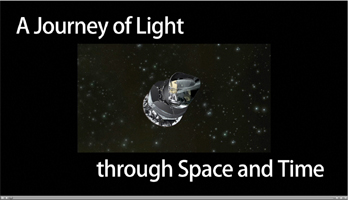
Click on the image for the animation
This artist's animation depicts the "life" of a photon, or particle of light, as it travels across space and time, from the very early universe to the Planck satellite. By creating maps of the oldest light in the universe, Planck scientists are learning about the epic journey of light through the cosmos. The mission's maps showing this ancient light, called the cosmic microwave background, have revealed the most precise information yet about the universe's fundamental traits, such as its age, contents and the seeds of all structure, without which we would not exist.
The light's journey begins just moments after the big bang that created our universe 13.8 billion years ago. At that time, the universe was a hot plasma of electrons, protons and photons (green and red balls, and blue linear particles, respectively). The light repeatedly bounces off electrons, and as result can't travel very far. Later, about 370,000 years after the big bang, the universe cools enough for the electrons and protons to get together to form hydrogen atoms. Electrons no longer get in the way of the light, and it is free to travel.
The light passes through the "dark ages" of the universe before stars and galaxies form, then witnesses the early stages of star and galaxy formation. It travels by large clusters of galaxies, whose gravity causes the path of the light to bend. Also influencing the light's tour are electrons in hot gas trapped in galaxy clusters. These electrons once again scatter the light, but not to the degree experienced in the very early universe.
As the universe expands during this time, the energy of the photons drops, shifting to longer wavelengths. By the time the photons reach Planck, they have shifted to low-energy microwaves. In this animation, that process of shifting to lower energies, called "red-shifting" is represented by a change in color from blue to red, since blue light is higher in energy than red.
Eventually, the light reaches the Planck satellite, which orbits in a stable position called the Lagrange point, 1.5 million kilometers (930,000 miles) from Earth. Planck scans the sky continuously, picking up the glow of the ancient light all around us, creating maps like the one shown at the end of the animation behind Earth. Scientists decipher patterns in this map, which reveal clues about what our universe is made of and how it came to be.
Planck is a European Space Agency mission, with significant participation from NASA. NASA's Planck Project Office is based at NASA's Jet Propulsion Laboratory, Pasadena, Calif. JPL contributed mission-enabling technology for both of Planck's science instruments. European, Canadian and U.S. Planck scientists work together to analyze the Planck data.
More information is online at http://www.nasa.gov/planck, http://planck.caltech.edu and http://www.esa.int/planck.

